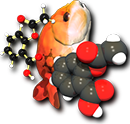Updating to Open Babel 3.0 from 2.x¶
Open Babel 3.0 breaks the API in a number of cases, and introduces some new behavior behind-the-scenes. These changes were necessary to fix some long standing issues impacting chemical accuracy as well as performance.
Here we describe the main changes, and how to change existing code to adapt.
Removal of babel¶
The babel executable has been removed, and obabel should be used instead. Essentially obabel is a modern version of babel with additional capabilities and a more standard interface. Typically the only change needed is to place -O before the output filename:
$ babel -ismi tmp.smi -omol out.mol
$ obabel -ismi tmp.smi -omol -O out.mol
Specifically, the differences are as follows:
obabel requires that the output file be specified with a
-Ooption. This is closer to the normal Unix convention for commandline programs, and prevents users accidentally overwriting the input file.obabel is more flexible when the user needs to specify parameter values on options. For instance, the
--uniqueoption can be used with or without a parameter (specifying the criteria used). With babel, this only works when the option is the last on the line; with obabel, no such restriction applies. Because of the original design of babel, it is not possible to add this capability in a backwards-compatible way.obabel has a shortcut for entering SMILES strings. Precede the SMILES by -: and use in place of an input file. The SMILES string should be enclosed in quotation marks. For example:
obabel -:"O=C(O)c1ccccc1OC(=O)C" -ocan
More than one can be used, and a molecule title can be included if enclosed in quotes:
obabel -:"O=C(O)c1ccccc1OC(=O)C aspirin" -:"Oc1ccccc1C(=O)O salicylic acid" -ofpt
obabel cannot use concatenated single-character options.
Python module¶
In OB 3.x, both openbabel.py and pybel.py live within the openbabel module:
# OB 2.x
import openbabel as ob
import pybel
# OB 3.0
from openbabel import openbabel as ob
from openbabel import pybel
While more verbose, the new arrangement is in line with standard practice and helps avoid conflict with a different Python project, PyBEL.
Atom classes¶
In OB 2.x, atom class information was stored as part of an OBAtomClassData object attached to an OBMol and accessed via OBMol.GetData("Atom Class"). In OB 3.0, atom class information is instead stored as an OBPairInteger associated with an OBAtom and accessed via OBAtom.GetData("Atom Class").
OBAtom valence and degree methods¶
OB 2.x referred to the function that returned the explicit degree of an atom as GetValence(). This was confusing, at best. To find the explicit valence, the BOSum() method was required. OB 3.0 avoids this confusion by renaming methods associated with degree or valence:
OBAtom::GetExplicitValence()(OB 2.xBOSum())OBAtom::GetExplicitDegree()(OB 2.xGetValence())OBAtom::GetHvyDegree()(OB 2.xGetHvyValence())OBAtom::GetHeteroDegree()(OB 2.xGetHeteroValence())
Molecule, atom and bond flags¶
The “Unset” methods for molecule, atom and bond flags have been removed. Instead, a value of false should be passed to the corresponding “Set” method. For example, OBMol::UnsetAromaticPerceived() in OB 2.x is now OBMol::SetAromaticPerceived(false).
Removal of deprecated methods¶
Several deprecated methods have been removed. For the most part, an equivalent function with a different name is present in the API:
OBBond::GetBO()/SetBO()removed.OBBond::GetBondOrder()/SetBondOrder()should be used instead.OBAtom::GetCIdx()removed.OBAtom::GetCoordinateIdx()should be used instead.OBBitVec::Empty()removed.OBBitVec::IsEmpty()should be used instead.OBBitVec::BitIsOn()removed.OBBitVec::BitIsSet()should be used instead.
Handling of implicit hydrogens¶
With OB 3.0, the number of implicit hydrogens is stored as a property of the atom. This value can be interrogated and set independently of any other property of the atom. This is how other mature cheminformatics toolkits handle implicit hydrogens. In contrast, in OB 2.x this was a derived property worked out from valence rules and some additional flags set on an atom to indicate non-standard valency.
From the point of view of the user, the advantage of the 2.x approach was that the user never needed to consider the implicit hydrogens; their count was calculated based on the explicit atoms (a behavior known as “floating valence”). The disadvantage was that it was difficult for the user to specify non-standard valencies, may have papered-over problems with the data, gave rise to subtle bugs which were not easily addressed and had poorer performance.
As an example of how the behavior has changed, let’s look at creating a bond. If we read the SMILES string C.C, create a bond between the two atoms and write out the SMILES string, we get different answers for OB 2.x (CC) versus OB 3.0 ([CH4][CH4]). OB 2.x just works out the count based on standard valence rules. With OB 3.0, there were four implicit hydrogens on each carbon before we made the bond, and there still are four - they didn’t go anywhere and weren’t automatically adjusted.
While this may seem like a major change, adapting code to handle the change should be straightforward: adding or removing a bond should be accompanied by incrementing or decrementing the implicit hydrogen count by the bond order. This also applies to deleting an atom, since this deletes any bonds connected to it. Note that care should be taken not to set the hydrogen count to a negative value when decrementing.
unsigned int bondorder = 1;
mol->AddBond(1, 2, bondorder);
OBAtom* start = mol->GetAtom(1);
unsigned int hcount = start->GetImplicitHCount();
start->SetImplicitHCount(bondorder >= hcount ? 0 : hcount - bondorder);
OBAtom* end = mol->GetAtom(2);
hcount = end->GetImplicitHCount();
end->SetImplicitHCount(bondorder >= hcount ? 0 : hcount - bondorder);
For the particular case of creating a new atom, it is worth noting that the implicit hydrogen count defaults to zero and that users must set it themselves if necessary. To help with this situation a convenience function has been added to OBAtom that sets the implicit hydrogen count to be consistent with normal valence rules. TODO
Regarding specific API functions, the following have been removed:
OBAtom::SetImplicitValence(),GetImplicitValence()OBAtom::IncrementImplicitValence(),DecrementImplicitValence()OBAtom::ForceNoH(),HasNoHForce(),ForceImplH(),HasImplHForced()OBAtom::ImplicitHydrogenCount()
The following have been added:
OBAtom::SetImplicitHCount(),GetImplicitHCount()
Handling of aromaticity¶
Molecule modification no longer clears the aromaticity perception flag. If the user wishes to force reperception after modification, then they should call OBMol::SetAromaticPerceived(false).
